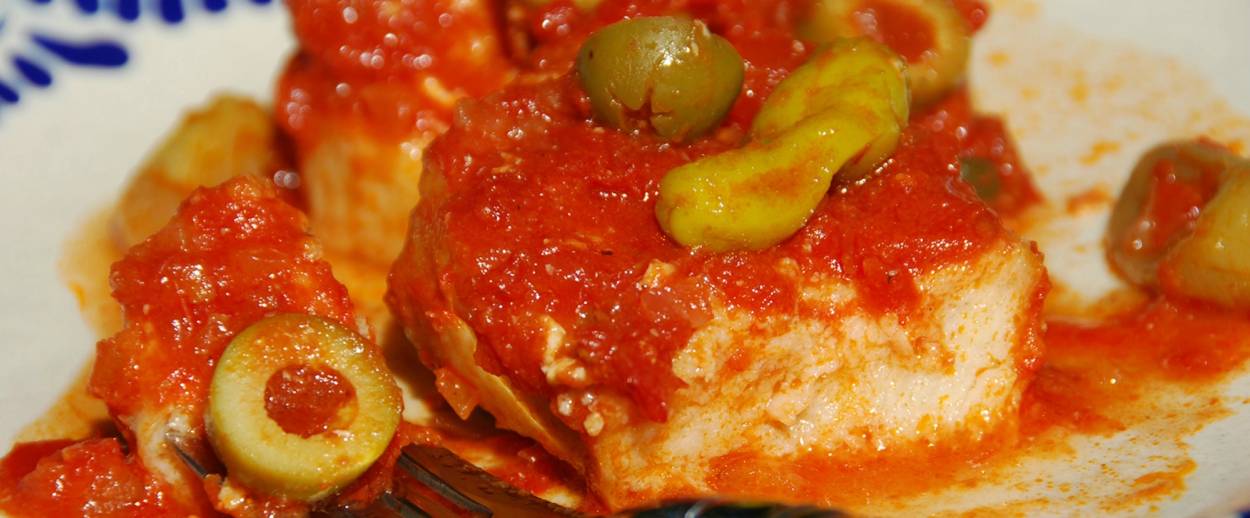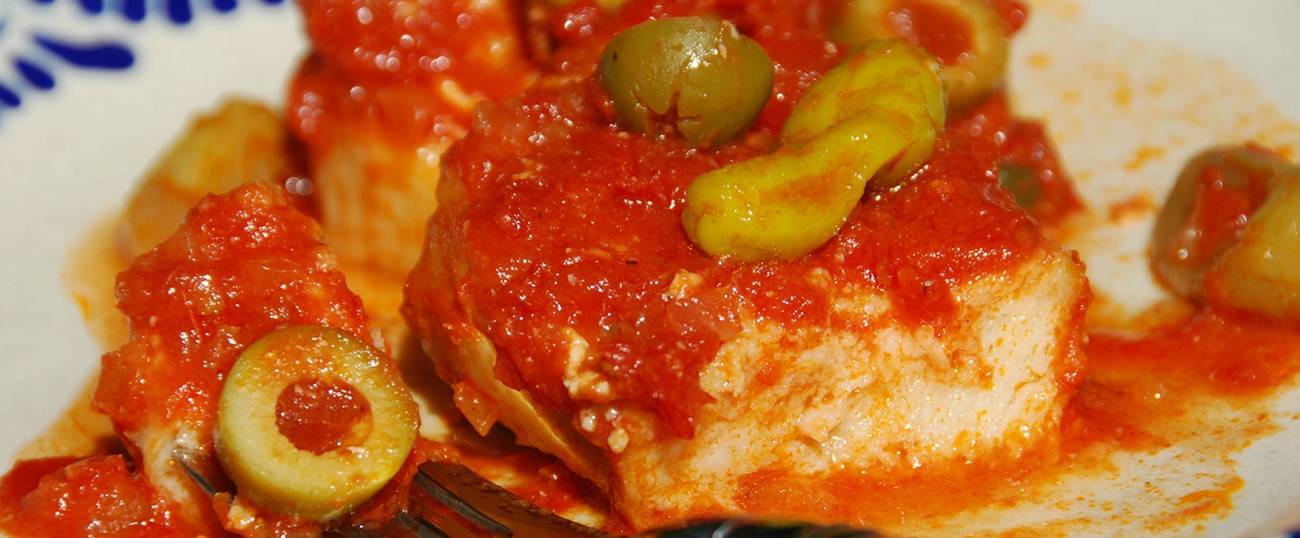Mexican-Jewish Food Is the Obsession You Need Right Now
Think you know gefilte fish? Try it a la Veracruzana.




The first time you eat gefilte fish Veracruzana you realize that your whole concept of gefilte fish needs to be turned on its head, that a new gefilte fish line needs to be drawn, not just the line that divides the sweet and the salty, but one dividing the spicy from the non-spicy; the hot from cold. Like traditional Ashkenazi-style gefilte fish, Veracruz-style gefilte fish still centers around a poached fish ball, but that’s where the similarities end. Instead of being made of carp and other cold water fish, it’s constructed from the Gulf of Mexico-dwelling red snapper. Instead of being served cold in its own jellied stock, it’s served warm and poached in a spicy sauce of tomatoes, capers, chilies, peppers, and olives. It is the most delicious gefilte fish I’ve ever eaten.
I was fortunate enough to have Emmy-nominated PBS cooking star and author Pati Jinich’s gefilte fish Veracruzana at an event celebrating Mexican-Jewish food at The General Muir in Atlanta. A collaboration between the Atlanta American Jewish Committee and the World Affairs Council of Atlanta, the event was sold out, with 105 people packing into the restaurant to hear TGM’s chef Todd Ginsberg and Jinich discourse on their culinary inspirations.
I assumed that the gefilte fish Veracruzana was a new dish that Jinich had concocted in her kitchen, but it turns out that it’s a traditional Mexican-Jewish dish. “The Veracruz style gefilte fish is in every Ashkenazi Mexican home that I know,” Jinich said. “It’s what Ashkenazi Jewish Mexicans do.”
Born in Mexico City, Jinich grew up eating this gefilte fish every Friday night. Jinich’s grandparents on both sides of the family immigrated to Mexico from Europe. Her father’s parents came from Poland in the 1920s, escaping pogroms. Her mother’s parents arrived from Austria, fleeing World War Two. Neither of them were aiming to come to Mexico, but after being turned away from Ellis Island, that’s where they ended up. “They all entered Mexico from the port of Veracruz which was the main port of entry for immigrants.” And that’s how the dish of gefilte fish Veracruz was born. “It’s sort of emblematic of Jewish entry into Mexico,” Jinich said.
The gefilte fish I ate was the same gefilte fish Jinich’s Polish grandmother served her, down to the addition of ketchup in the sauce.
Mexican-Jewish food is virtually unknown in America, even among Jews. “I didn’t even know there was such a thing and an abundance of Jews living in Mexico city,” Ginsberg said. Similarly Dov Wilker, Regional Director of AJC Atlanta said, “It was totally new to me. I said, ‘What are we going to have, gefilte fish tacos?”
In fact, it’s a new career focus for Jinich as well. “I didn’t used to do a lot of stuff in a culinary sense with my Jewishness because I was focused on opening a door into Mexico for the Americans,” Jinich said. “I have the responsibility of showing that Mexicans can be a great contribution to any society. I’m very proud about my Mexican heritage… and the same goes to the Jewish side.”
All of Jinich’s dishes played off of the mixing of Mexican and Jewish cultures. She served a matzoh ball soup, which from a distance it looked like the traditional matzo ball soup—a large fluffy tennis ball-sized dumpling bobbing in broth—but upon closer inspection revealed its Mexican influence: Scattered throughout the broth were chopped jalapeno peppers and mushrooms. And the matzo balls weren’t traditional either: they featured toasted sesame oil and a splash of seltzer.
This is a traditional recipe within Jinich’s family, a slight variation on the matzo ball soup Jinich’s bubbe made. Jinich added a lot more peppers in honor of her grandfather, a pepper aficionado whose wife, Jinich’s grandmother, restricted his pepper intake because she thought they were bad for his health. To get around her restrictions, he would stash peppers in his pockets, even wet pickled peppers, and secretly chomp on them.
The event at TGM was the first time the restaurant has hosted a Mexican-Jewish food event. Because Ginsberg knew very little about the cuisine, the menu was mainly crafted by Jinich.
It was a struggle for Ginsberg to not tweak Jinich’s recipes. “Part of me in the very beginning was like alright I should do it this way, it will make it taste better,” Ginsberg said. “And I was like, I’m going to do it the way she says…It turned out amazing.” However, one of the dishes was Ginsberg’s creation, a spicy, Mexican-inspired sweet potato dish with crispy sweet potato skins, spiced raisins and pumpkin seeds.
The main course strayed from Mexican-Jewish tradition. It was a brisket cooked with piloncillo (a form of sugar cane) and pasilla (a dried chile), which Jinich invented. “In Michoacan they mix that combination of ingredients with pork and they call it carne enchilada,” Jinich said. “ When thinking about what to do for one of the Jewish holidays, six or seven years ago I wanted to do a brisket and I was tired of the tomato-y brisket, which is also fabulous, but I wanted to do something different.” The fork-tender brisket balanced sweet and spicy flavors perfectly.
Although Mexican-Jewish food exists in Mexico City, aside from one-off events like the Jinich-General Muir collaboration, it hasn’t really crossed the border to the U.S. That’s a shame. Americans would no doubt gobble up the pastrami enchiladas, salami tacos, and chocolate babka (made with Mexican cinnamon and chocolate) consumed in Mexico City. Along with enjoying the cuisine, Americans could also expand their idea of what a Jew looks like.
“When people think about Jews in America they think about Jews that are otherwise seen as white people,” Wilker said. “Anything that can showcase the diversity of the Jewish community, I take advantage of.”
Mexicans are already cooking in American Jewish restaurants. Around half of Ginsberg’s kitchen is made up of Mexicans, who were excited to cook Mexican-Jewish dishes. “The people that I work with in my kitchens. They’re my heroes,” Ginsberg said. “ They’ve come to this country, left their families and are working hard for a better life. So I always stand strong with them. So I was very proud of that dinner despite the political environment right now.”
Hallie Lieberman is a writer and historian who is the author of the forthcoming Buzz: A Stimulating History of the Sex Toy.